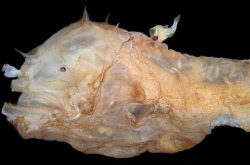
Deep-sea anglerfishes employ an incredible reproductive strategy. Tiny dwarfed males become permanently attached to relatively gigantic females, fuse their tissues and then establish a common blood circulation. In this way, the male becomes entirely dependent on the female for nutrient supply, like a developing fetus in the womb of a mother or a donated organ in a transplant patient.
In anglerfishes, this unusual phenomenon is called “sexual parasitism” and contributes to the reproductive success of these animals living in the vast space of the deep sea, where females and males otherwise rarely meet.
Now scientists from the Max Planck Institute of Immunobiology and Epigenetics in Germany and the University of Washington have figured out why female anglerfishes so readily accept their male mates. Their findings are published July 30 in Science.
“How is it possible that genetically similar organisms — in this case, members of the same species — accept each other so readily when tissue rejection is the usual and expected result of any such union?” said co-author Ted Pietsch, professor emeritus at the UW School of Aquatic and Fishery Sciences. “Just witness the difficulties surrounding organ transplantation in humans. We now see great potential down the road for a better understanding of the problem.”
Read more at UW News »
